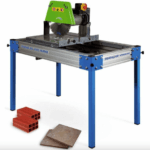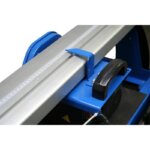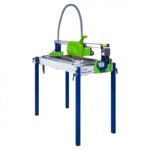There are several DIY projects around the house that require brick cutting, from fireplace façades to outdoor pizza ovens. Some small projects that don’t call for very much cutting could certainly be done the old fashioned way, with no saw at all. However, most medium to large projects will be accomplished much faster and more easily using a brick saw.
Like tile saws, a brick saw is a type of masonry saw that uses a special diamond blade to grind through the hard material while being cooled with flowing water. These tools are similar enough that, as long as you have the correct type and size of diamond blade, you can use them interchangeably: any good masonry saw will cut brick beautifully when equipped with the proper blade, and a good tile saw that allows a blade diameter of at least 10” will also get the job done.
Contents
Why use a brick saw or masonry saw for cutting brick?
Using a specially designed saw for cutting bricks offers several advantages over the manual method or using a hand circular saw. First, these sturdy bench/table saws are much easier to use and don’t require a lot of technique to get a perfect cut. Your results will look much more professional with less effort if you wet cut your brick with one of these machines.
The process will also be much faster and more efficient, which is especially important if you decided to rent a brick saw instead of buying your own brick cutting saw. Finally, masonry saws have blade-cooling systems built-in in the form of water pumps or attachments, which significantly reduces the amount of dust produced when cutting bricks.
Cutting by hand with a circular saw makes water cooling complicated and quite dangerous, perhaps equally as dangerous as the dust itself. Dust from cutting brick isn’t just a nuisance; it can cause severe, irreversible lung damage.
How to cut bricks and pavers with a wet brick saw
Once your masonry saw, tile saw or brick saw is set up and has been fitted with the correct diamond blade for cutting brick, the cutting process is quite simple. For safety purposes, ensure that no loose clothing or hair is at risk of getting caught in the machine, and always wear appropriate protective equipment (goggles or face shield, gloves, ear protection, steel toe boots, and a respirator if dry cutting). Things can get wet and muddy, so you might want to put on a shop apron to protect your clothes.
Before cutting, always make sure the blade is in good condition and properly mounted, with no strange wobbling or vibrating. It’s a good idea to periodically check electrical cords, belts, and the oil level in the saw’s motor. Make sure that water flows freely over the blade.
Even if your blade is large enough to cut the entire brick in a single pass, it’s better to cut in two or more shallow passes. This will extend the life of your blade and keep things from overheating. After measuring and marking your cutting line, simply line the cutting line up with the brick saw, start the water flow and turn the saw on. Slowly and carefully guide the brick into the blade (or the blade into the brick, depending on your saw model).
Don’t exert too much force, and don’t try to steer the brick by pushing on the sides. Once you finish your first pass, repeat the process to cut through the remainder of the brick.





